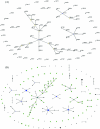Population dynamics of Neisseria gonorrhoeae in Shanghai, China: a comparative study
- PMID: 20092631
- PMCID: PMC2822776
- DOI: 10.1186/1471-2334-10-13
Population dynamics of Neisseria gonorrhoeae in Shanghai, China: a comparative study
Abstract
Background: Gonorrhea is a major sexually transmitted disease (STD) in many countries worldwide. The emergence of fluoroquinolone resistance has complicated efforts to control and treat this disease. We report the first study of the evolutionary processes acting on transmission dynamics of a resistant gonococcal population from Shanghai, China. We compare these findings with our previous study of the evolution of a fluoroquinolone sensitive gonococcal population from Baltimore, MD.
Methods: Ninety six gonococcal samples were collected from male patients in Shanghai, China. All samples were fluoroquinolone resistant. Seven MLST housekeeping genes, two fluoroquinolone resistance genes (gyrA and parC) and the porB gene were sequenced and subjected to population genetic and evolutionary analyses. We estimated genetic diversity, recombination, growth, and selective pressure. The evolutionary history and population dynamics of the Shanghai population were also inferred and compared with that observed in a fluoroquinolone sensitive gonococcal population from Baltimore.
Results: For both populations, mutation plays a larger role than recombination in the evolution of the porB gene, whereas the latter seems to be the main force driving the evolution of housekeeping and fluoroquinolone resistance genes. In both populations there was evidence for positively selected sites in all genes analyzed. The phylogenetic analyses showed no temporal clustering in the Shanghai gonococcal population, nor did we detect shared allelic profiles between the Shanghai and the Baltimore populations. Past population dynamics of gonococcal strains from Shanghai showed a rising relative effective population size (Ne) in MLST genes with a declining relative Ne for gyrA and parC, whereas among sensitive strains from Baltimore we previously observed concordance among these genes. In both Shanghai and Baltimore, the past population dynamics of gonococcal strains tracked changes in the prevalence of gonorrhea.
Conclusions: Our study illustrates both similarities and differences in the evolutionary processes acting on gonococcal populations in different geographic areas. An explanation of this pattern that may apply in China is the continued use of quinolone antibiotics despite widespread resistance. Population genetic analysis of gonococcal strains in conjunction with epidemiological surveillance may provide insights into the epidemic behavior of antibiotic resistant strains and help to design control measures.
Figures




Similar articles
-
Population genetics of Neisseria gonorrhoeae in a high-prevalence community using a hypervariable outer membrane porB and 13 slowly evolving housekeeping genes.Mol Biol Evol. 2005 Sep;22(9):1887-902. doi: 10.1093/molbev/msi184. Epub 2005 Jun 8. Mol Biol Evol. 2005. PMID: 15944444
-
Fluoroquinolone resistance among Neisseria gonorrhoeae isolates from Shanghai, China: detection of quinolone resistance-determining region mutations.Indian J Med Res. 2009 Jun;129(6):701-6. Indian J Med Res. 2009. PMID: 19692753
-
Distinguishing importation from diversification of quinolone-resistant Neisseria gonorrhoeae by molecular evolutionary analysis.BMC Evol Biol. 2007 Jun 1;7:84. doi: 10.1186/1471-2148-7-84. BMC Evol Biol. 2007. PMID: 17543117 Free PMC article.
-
Fluoroquinolone-resistant Neisseria gonorrhoeae: the inevitable epidemic.Infect Dis Clin North Am. 2005 Jun;19(2):351-65. doi: 10.1016/j.idc.2005.03.005. Infect Dis Clin North Am. 2005. PMID: 15963876 Review.
-
Will targeting oropharyngeal gonorrhoea delay the further emergence of drug-resistant Neisseria gonorrhoeae strains?Sex Transm Infect. 2015 Jun;91(4):234-7. doi: 10.1136/sextrans-2014-051731. Epub 2015 Apr 24. Sex Transm Infect. 2015. PMID: 25911525 Review.
Cited by
-
Molecular basis of high-level ciprofloxacin resistance in Neisseria gonorrhoeae strains from Shandong Province, China.Braz J Microbiol. 2013 May 7;44(1):273-6. doi: 10.1590/S1517-83822013005000020. eCollection 2013. Braz J Microbiol. 2013. PMID: 24159315 Free PMC article.
-
Microbial sequence typing in the genomic era.Infect Genet Evol. 2018 Sep;63:346-359. doi: 10.1016/j.meegid.2017.09.022. Epub 2017 Sep 21. Infect Genet Evol. 2018. PMID: 28943406 Free PMC article. Review.
-
The Impact of Selection, Gene Conversion, and Biased Sampling on the Assessment of Microbial Demography.Mol Biol Evol. 2016 Jul;33(7):1711-25. doi: 10.1093/molbev/msw048. Epub 2016 Mar 1. Mol Biol Evol. 2016. PMID: 26931140 Free PMC article.
-
Longitudinal analysis of the evolution and dissemination of Neisseria gonorrhoeae strains (Saskatchewan, Canada, 2005 to 2008) reveals three major circulating strains and convergent evolution of ciprofloxacin and azithromycin resistance.J Clin Microbiol. 2012 Dec;50(12):3823-30. doi: 10.1128/JCM.01402-12. Epub 2012 Sep 12. J Clin Microbiol. 2012. PMID: 22972828 Free PMC article.
-
Molecular phylodynamics and protein modeling of infectious salmon anemia virus (ISAV).BMC Evol Biol. 2011 Dec 2;11:349. doi: 10.1186/1471-2148-11-349. BMC Evol Biol. 2011. PMID: 22132866 Free PMC article.
References
-
- Gerbase AC, Rowley JT, Heymann DH, Berkley SF, Piot P. Global prevalence and incidence estimates of selected curable STDs. Sex Transm Infect. 1998;74:S12–16. - PubMed
-
- Sparling PF, Handsfield HH. In: Principles and Practice of Infectious Diseases. Mandel GL, editor. 2000. Neisseria gonorrhoeae; p. 2246.
-
- Van Vranken M. Prevention and treatment of sexually transmitted diseases: an update. Am Fam Physician. 2007;76:1827–1832. - PubMed
-
- Alary M, Laga M, Vuylsteke B, Nzila N, Piot P. Signs and symptoms of prevalent and incident cases of gonorrhea and genital chlamydial infection among female prostitutes in Kinshasa, Zaire. Clin Infect Dis. 1996;22:477–484. - PubMed
Publication types
MeSH terms
Substances
Grants and funding
LinkOut - more resources
Full Text Sources
Other Literature Sources
Medical
Research Materials
Miscellaneous

